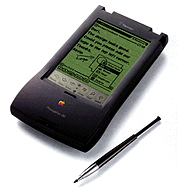
The Newton® compatible PDA
The Personal Digital Assistant (PDA) is a pocket sized computing device which could be described as a mixture of an organiser and a laptop PC. A soft plastic pen is used for entering data and commands. Text may be entered by directly writing onto the screen and using the built-in handwriting recognition or by using an on-screen keyboard. Commands are entered by tapping onto on-screen buttons and popup menus. An optional external keyboard may be connected for entering long text.
In addition to built-in applications such as notebook, to-dolist, phone list, datebook, telefone log, addressfile, e-mailing and more there is a big pool with PD, shareware and ommercial software for a lot of different applications.
By connecting a modem (either PC card or external, also GSM) you can use the PDA for e-mailing, faxing or even Web browsing.
Having only black and white displays on actual PDAs needs not to be a disadvantage, because colour displays always needs background illumination, much more energy, and have a very bad readability at day light. A colour PDA would be much more unmanageable and heavy. Because of the storage size of colour maps it would need a micro hard disk it would need even more energy. It would be nearly a portable PC then.

The MessagePad 130 as shown above is actual entry-level model. Thanks to its low weight, on-demand backlighting, nonglare screen and high battery performance it is especially suitable for usage in air plane cockpits down to the lightweight planes. It may be used as a replacement for the traditional kneeboard e.g. for working with checklists, or as described here, as a GPS based navigation aid with moving map display.
The MessagePad 2000 as shown on the title page is the newest Newton compatible PDA and has a Strong-ARM processor running at 162 MHz, giving it five to ten times more performance compared to the MP 130. The MP 2000 has two PC-card slots while the MP 130 has one. It has 5 Megabytes internal memory and a new screen with twice the amount or pixels and sixteen shades of gray. It is so good that a map may be displayed scaled 1:1 compared to the original paper form, and it is still readable!
What is GPS Map?
GPS Map in combination with almost any GPS receiver makes your Newton compatibe PDA to a simple to operate, comfortable navigation system displaying real maps as on paper. GPS Map runs on all PDAs with operating system 1.3 or higher.
The power of this system was formerly only available with special developed hardware or with powerful PCs, where both are much more expensive. Compared to the specialised hardware that may be used for navigation purposes only and to PCs that are unmanageable and heavy, your PDA is handy, has almost the same features and still can be used for your daily work.
Most so called "moving map" systems (including GPS receivers with this feature) are based on the Jeppessen database or a clone and show very simple graphics composed of some lines and points only.
Compared to that GPS Map supports both scanned bitmap type maps and vector based maps, and supports all popular geographic map projection models.
Now you can load your preferred paper maps such as ICAO, approaching or airport maps with all details into GPS Map, and even draw your own vector based maps within a CAD application.
Vector maps (starting with version 1.5) even support a mixture of bitmap and vectors, e.g. for drawing land shapes as vectors into a nautical map and inserting harbours or islands as bitmaps.
Because the internal PDA memory may contain only small maps you may need an additional PCMCIA flash card. These cards are available with capacities up to 40 megabytes. The price is about DM 700.- for a 16 megabytes card.
The needed capacity depends on the amount and size of your requested maps, e.g. a 16 megabytes card has space for storing all ICAO map sheets for Germany in two resolutions, and there is still space available for storing some approaching maps.
What is GPS Map Lite?
GPS Map Lite is a simplified version which is thought as a low-cost alternative for non-professional users needing a simple map based navigation system with base functionality e.g. for hiking trips or driving.
Instead of route planning you can specify a target position and the system will permanently calculate direction and distance to your goal.
GPS Map and GPS Map Lite are using the same data formats, so that your maps will run with both.
GPS Requirements
There are no special requirements to the GPS receiver used because it will be used only as a position sensor.
The receiver must have a serial interface with the following specifications:
The popular NMEA protocol has many different implementations, but GPS Map and GPS Map Lite will adapt to them automatically. GPS Map and GPS Map Lite support the following NMEA message combinations:
If the messages to send are selectable at your GPS receiver you should prefer the combinations 1 and 2, because of 3 and 4 don't contain information about height and data quality. If the receiver sends additional messages they will be suppressed automatically..
Because the NMEA protocol does not support any handshake the GPS receiver should not send too many messages per second to avoid overruns in the PDA's serial driver. Currently only the Trimble Personal Locator is known as a problem.
If you intend to use a non NMEA receiver and if you are able to program the interface by yourself you can order the optional GPS Driver Toolkit.